A Stroll Around the Old City Walls: The Gates of Jerusalem
Introduction to the Gates of Jerusalem
Encased within ancient walls, the Old City holds eight gates, each with its own story. Of the gates of Jerusalem, seven are open, and one is sealed, waiting for the pages of prophecy to turn.
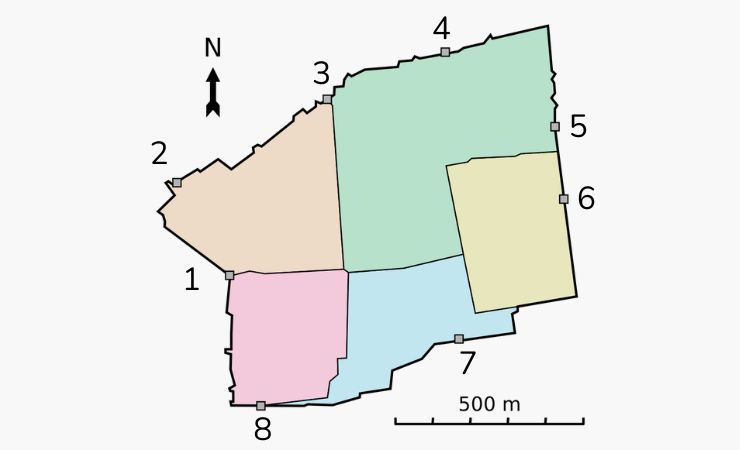
1. Jaffa Gate: Where Pilgrims Enter
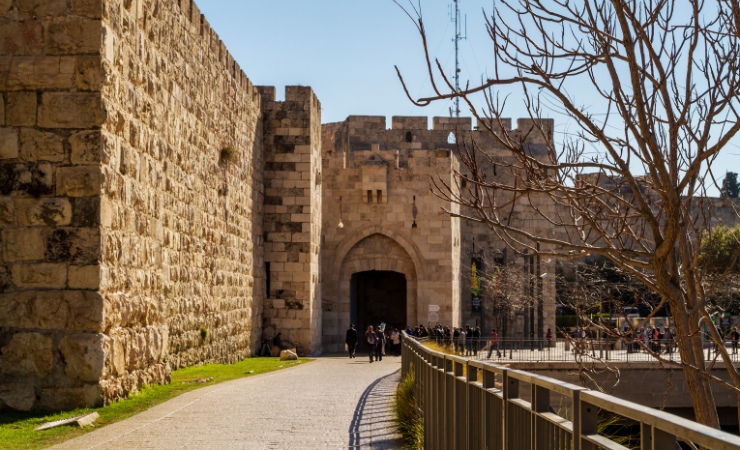
Location: Western side of the Old City.
Built In: 1538.
Names in Three Languages: English: Jaffa Gate, Hebrew: שער יפו, Arabic: باب الخليل.
Built in 1538 by the Ottomans, the Jaffa Gate, or Sha’ar Yafo in Hebrew, is named after the ancient port of Jaffa. Arabic speakers, on the other hand, refer to it as Bāb al-Khalīl or “Hebron Gate”.
The L-shaped entryway was designed to slow down oncoming attackers. Now, it just adds to the charm and the historical atmosphere.
In 1898, the Ottoman authorities made a breach in the city wall near Jaffa Gate to allow German emperor Wilhelm II to enter the city triumphantly. It’s through this gap that cars can now access the Old City from the west.
Read more about the Jaffa Gate
2. The New Gate
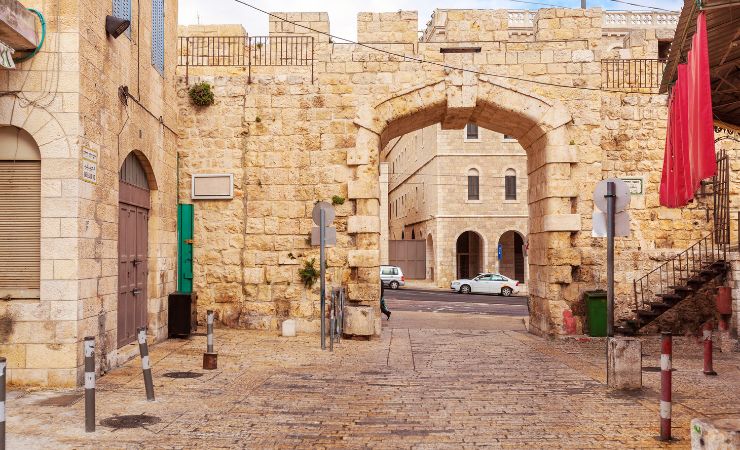
Location: Northeastern side.
Built In: 1875.
Names in Three Languages: English: Herod’s Gate, Hebrew: שער הפרחים, Arabic: باب الساهرة.
The New Gate, Sha’ar Hadash in Hebrew and Bab al-Jadid in Arabic, is the newest addition to the walls of Jerusalem’s Old City. It was built at the end of the 19th century during the rule of the Ottoman Empire. The gate was opened to facilitate direct access for Christian pilgrims to the Christian Quarter and the Church of the Holy Sepulchre.
Unlike the other gates, the New Gate has a relatively modest architectural design. Nonetheless, it played a significant role in the development of Jerusalem in the late 19th and early 20th centuries.
During the 20th century, the area around the New Gate became home to several religious institutions, including convents and monasteries. Today, it is a hub for Christian pilgrims from around the world, and the area surrounding it has a distinctly European flavor with its narrow, winding streets and ancient buildings.
Read the full article about the New Gate
3. Damascus Gate: A Bustling Passage from the North
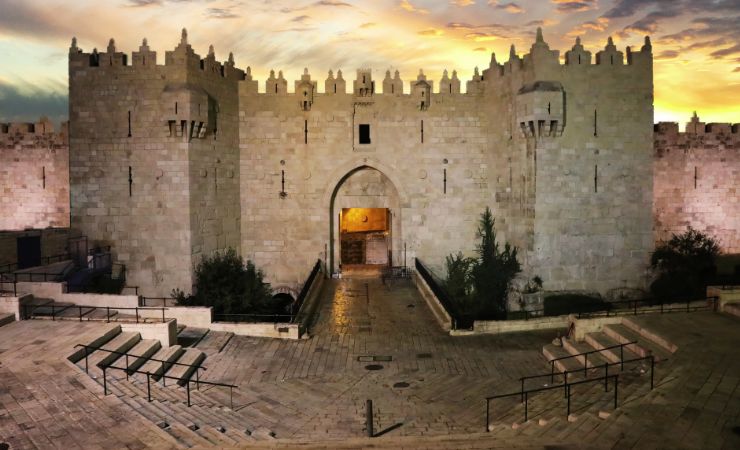
Location: Northern Wall.
Built In: 1537.
Names in Three Languages: English: Damascus Gate, Hebrew: שער שכם, Arabic: باب العامود.
Damascus Gate, known as Sha’ar Shechem in Hebrew and Bab al-Amud in Arabic, is one of the most imposing and beautiful of Jerusalem’s gates. Built in 1537 by Sultan Suleiman the Magnificent, it’s located on the northern wall. The name comes from the fact that the road leading from this gate heads northward to Damascus. The gate is also called Bab al-Amud, meaning “Gate of the Column,” because of the tall column that stood here in the Roman and Byzantine eras.
The gate’s architectural splendor is a testament to its historical significance. With an ornate facade featuring an arched entryway, the Damascus Gate is a hub of activity. As you approach, you’re greeted by the inviting aromas of freshly baked bread, spices, and coffee from the bustling market.
Interestingly, beneath the modern-day Damascus Gate lie the remains of a Roman gate, built around 135 CE, which was part of a larger Roman plaza. Excavations have revealed an arched entryway and a guardhouse that was part of the Roman gate.
The gate has also been a site of political and social gatherings. For instance, during the British Mandate period, demonstrations against British policies in Palestine would often take place in front of Damascus Gate.
In recent years, the gate and its surrounding areas have become a melting pot of cultures, with a diverse array of shops, markets, and eateries.
Read the full article about the Damascus Gate.
4. Herod’s Gate: Flowers and Fortresses
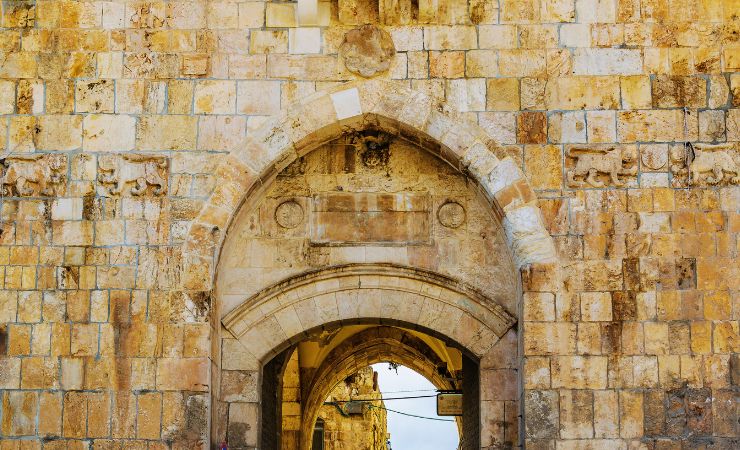
Location: Northeastern side.
Built In: 1539.
Names in Three Languages: English: Herod’s Gate, Hebrew: שער הפרחים, Arabic: باب الساهرة.
Also known as the Flower Gate, Herod’s Gate is known as Sha’ar HaPrakhim in Hebrew and Bab as-Sahira in Arabic. Located in the northern wall, it is one of the lesser-known gates of the Old City. The gate was named after Herod Antipas, although it is not definitively associated with him. The name Flower Gate originates from the rosette carved into the gate’s stonework.
Built in 1539, Herod’s Gate features a modest facade with a single, unadorned arch. Unlike other gates, it doesn’t lead to any major religious sites, which is why it tends to be less crowded.
It was around this area that the Crusaders successfully conquered Jerusalem in 1099.
Read the full article about Herod’s Gate.
5. Lion’s Gate: A Hellow from Baybars
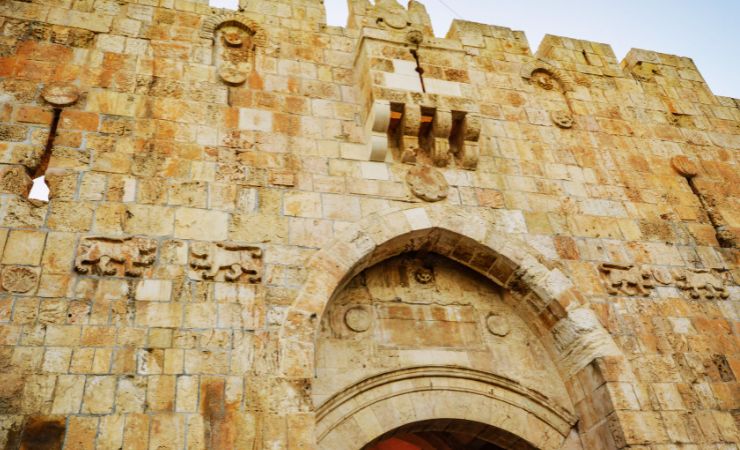
Location: Eastern Wall.
Built In: 1517.
Names in
Three Languages: English: Lion’s Gate, Hebrew: שער האריות, Arabic: باب الأسباط.
Lion’s Gate, known as Sha’ar HaArayot in Hebrew and Bab Sittna Maryam in Arabic, is located in the eastern section of the Old City walls. Built in 1538, it is named after the four lion figures carved into the gate’s facade. The gate is also known as St. Stephen’s Gate, associated with the martyrdom of Saint Stephen, who is said to have been stoned to death nearby.
Legend has it that Sultan Suleiman the Magnificent built the gate in response to a dream where he was attacked by lions, which he interpreted as a divine signto protect Jerusalem by building a wall. The lions, in particular, are believed to represent the protective presence.
During the Six-Day War in 1967, the IDF entered the Old City of Jerusalem through the Lion’s Gate, and the event is commemorated near the gate. The area around Lion’s Gate is steeped in history and religious significance for Jews, Christians, and Muslims alike.
Close to the gate is the Pools of Bethesda, where, according to the New Testament, Jesus performed the miracle of healing a paralyzed man. The Via Dolorosa, believed to be the path that Jesus walked on the way to his crucifixion, also begins near this gate.
Read the full article about the Lion’s Gate.
6. Golden Gate: A Sealed Prophecy
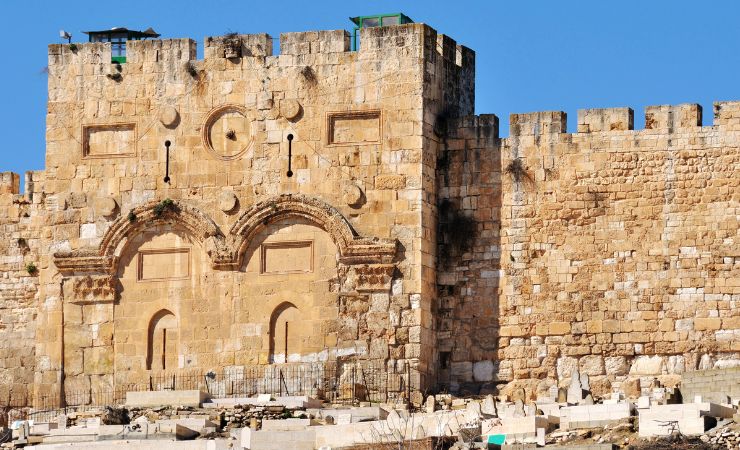
Location: Eastern Wall.
Built In: 6th-7th Century.
Names in Three Languages: English: Golden Gate, Hebrew: שער הרחמים, Arabic: باب الرحمة.
The Golden Gate, known as Sha’ar HaRachamim in Hebrew, meaning “Gate of Mercy”, and Bab al-Rahmah in Arabic, is one of the most ancient and significant gates in the walls of the Old City of Jerusalem.
Situated on the eastern side of the city, it faces the Mount of Olives and is directly opposite the Temple Mount.
Historically, it is believed to have been constructed during the Byzantine period in the 6th or 7th century, although some theories suggest it might date back to the time of the Second Jewish Temple. The gate has two large, blocked archways and has been sealed off for centuries. It holds immense religious importance for Jews, Christians, and Muslims alike. For Jews, it is believed to be the gate through which the Messiah will enter Jerusalem. Christians associate it with the triumphal entry of Jesus into the city on Palm Sunday. For Muslims, it has significance as it is close to the Al-Aqsa Mosque, and some Islamic traditions consider it to be the site where final judgment will occur.
Throughout history, the gate has undergone various periods of construction and repair, and its sealing has been a subject of political and religious tensions.
Read the full article about the Golden Gate.
7. Dung Gate: Access to Sacred Ruins
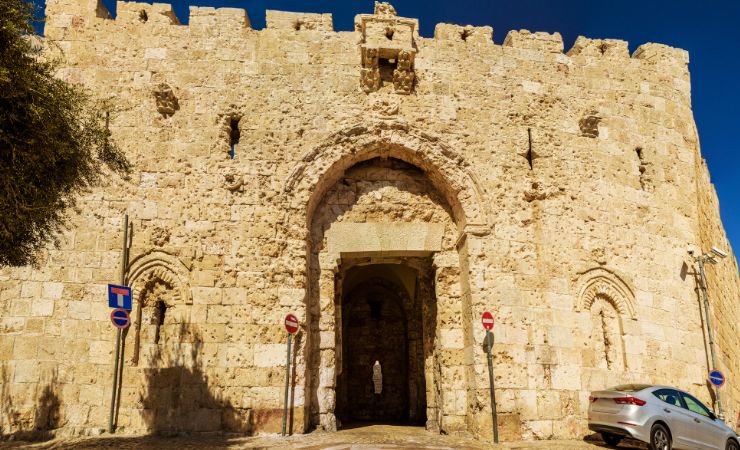
Location:Southern Wall.
Built In: 16th Century.
Names in Three Languages: English: Dung Gate, Hebrew: שער האשפות, Arabic: باب المغاربة.
The Dung Gate, or Sha’ar HaAshpot in Hebrew and Bab al-Magharbeh in Arabic, is situated near the southeastern corner of the Old City. Built in the 16th century, it’s believed to be named for the refuse that was historically taken through this gate to be discarded in the Kidron Valley.
Despite its unflattering name, the Dung Gate is a historically rich and significant entrance. It is the closest gate to the Western Wall, one of the holiest sites in Judaism, and therefore is frequented by Jewish worshipers. It also offers access to the Southern Wall Archaeological Park, where you can see important artifacts and remnants of ancient Jerusalem.
In the 20th century, the gate was widened to allow for vehicular traffic. In addition, an ornate, high arch was added, giving the gate a more imposing appearance.
Read the full article about the Dung Gate.
8. Zion Gate: Bullet Marks and Sacred Places

Location: Southern side.
Built In: 1540.
Names in Three Languages: English: Zion Gate, Hebrew: שער ציון, Arabic: باب صهيون.
Zion Gate, known as Sha’ar Zion in Hebrew and Bab Sahyun in Arabic. In Arabic, it’s also called Bab Harat al-Yahud, which translates to “Jewish Quarter Gate”, or Bab an-Nabi Dawud, meaning “Prophet David Gate”.
Zion Gate leads to Mount Zion, home to several key religious sites. But back in the 19th century, the surroundings were a little less glamorous, with a leper colony, slaughterhouse, and livestock market nearby.
On Zion Gate’s façade you’ll see bullet holes from the 1948 Arab-Israeli War, a reminder of Jerusalem’s turbulent past. And in 2008, Zion Gate had a bit of a facelift, with restoration work carried out to mark its 468th birthday.
The Room of the Room of the Last Supper and King David’s Tomb are only minutes away from the Zion Gate.
Read the full article about the Zion Gate.
Sources and Additional Reading about the Gates of Jerusalem
Wikipedia – Gates of the Old City of Jerusalem
FIRM Israel – Gates to the Old City of Jerusalem and Their Meaning
Jerusalem Story – The Gates of Jerusalem’s Old City


